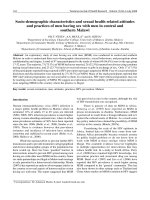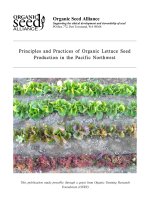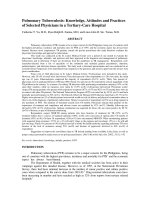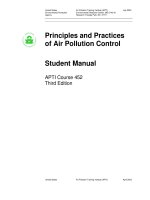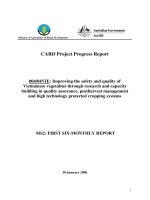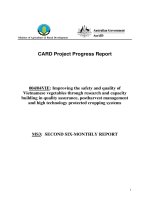Biosecurity and disease control perceptions and practices of vietnamese smallholder pig
Bạn đang xem bản rút gọn của tài liệu. Xem và tải ngay bản đầy đủ của tài liệu tại đây (387.34 KB, 46 trang )
Biosecurity and disease control perceptions and practices of Vietnamese smallholder pig
farmers.
Mayank Barot (430551727)
Bachelor of Veterinary Science
Faculty of Veterinary, University of Sydney
A thesis submitted for the Master of Veterinary Public Health
May 2017
1!
I declare that this dissertation is solely my own work
2014-2017
Mayank Barot
!2
Acknowledgements
I thank my collaborating colleagues and project partners from the Vietnam National
University of Agriculture (VNUA), Hanoi University of Public Health (HUPH) and staff from
the International Livestock Research Institute (ILRI) for conducting field work and helping to
facilitate the study. In addition, I thank all the farmers and local provincial partners for their
participation and assistance in the study. I thank Dr Fred Unger from ILRI as the supervisor of
this study and also Dr Jenny-Ann Toribio from the University of Sydney. This study was part
of a wider project “Reducing disease risks and improving food safety in smallholder pig value
chains in Vietnam” funded by the Australian Centre for International Agricultural Research
(ACIAR) (Grant number: LPS/2010/047) and the Consultative Group on International
Agricultural Research (CGIAR), Research Program Agriculture for Nutrition and Health
(A4NH).
!3
Abstract
Pork is the most widely consumed meat in Vietnam and plays a key role in meeting
the public demand for protein. It is estimated that 80% of pork consumed in Vietnam is
sourced from smallholder farmers who can have their animal production and livelihood
impacted by the introduction and spread of infectious diseases. Implementation of biosecurity
and disease control practices can play a crucial role in negating these impacts. This study
sampled 420 smallholder pig farmers in Vietnam to identify farmer perceptions and practices
relating to biosecurity and disease control. The study found a majority (82%) of farmers
reported experiencing one or more instances of pig disease in the last year, with self-treatment
as the first response for 70% of farmers. Other measures such as disinfection mattresses and
visitor control were used by 94% and 75% of the farmers respectively. Measures such as
rodent control and quarantine of animals were poorly adopted, with respective adoption rates
of 20% and 6%. Farmer perceptions revealed a desire to improve their knowledge and
understanding of pig production and specifically biosecurity and disease control practices.
Findings from this study will form part of a participatory approach to improving farm
production and livelihoods through a understanding of current biosecurity and disease control
practices and perceptions.
!
4
Table of Contents
Page Number
1.0 List of tables and figures
6
2.0 Abbreviations
8
3.0 Introduction and Literature review
9
4.0 Methods
17
5.0 Results
19
6.0 Discussion
30
7.0 References
38
!5
1.0 List of tables and figures
Table 1: Distribution of farmer gender and production type in study area
Graph 1: Farmer participation in additional value chain activities.
Table 2: Incidences of disease as reported by farmers by study area and production type.
Table 3: Practices and response to disease on farm, classified by farm location and farm
production type
Table 4: Frequency of farm visits for input suppliers
Table 5: Observational checklist of Farm Practices, classified by farm locatio and farm
production type
Graph 2: Farmer perceptions on diseases on farm being caused by their own production
practices
Graph 3: Farmer perceptions on diseases on farm being caused by actions of neighbouring
farms
Graph 4: Farmer perceptions on diseases on farm being caused by actions of traders
Graph 5: Farmer perceptions on selling pigs in response to disease outbreaks in community
Graph 6: Farmer perceptions on selling pigs in response to disease outbreaks on farm
Graph 7: Farmer perceptions on the importance of biosecurity and disease control standards
in pig production
!6
Graph 8: Farmer perceptions on seeking to generally improve their skills and knowledge on
pig production
Graph 9: Farmer perceptions on seeking to biosecurity and disease control practices
!7
2.0 Abbreviations
FMD: Foot and mouth disease
PRRS: Porcine reproductive and respiratory syndrome
CSF: Classical swine fever
PHFD: Porcine high fever disease
PCV2: Porcine circovirus type 2
SIV: Swine influenza virus
ADV: Aujeszky’s disease virus
ASF: African swine fever
VNUA: Vietnam National University of Agriculture
!8
3.0 Introduction and Literature review
Smallholder livestock farmers are a key source of food for populations in many
developing countries. With a growing demand for protein rich food sources, these farmers
face a number of challenges to ensuring that they can produce safe and sustainable products
for consumers (Grace, 2015). In Vietnam, livestock farming and production represents a
significant portion of the economy and plays a vital role in meeting the increasing nutritional
demands of the local population (Lapar et al., 2009). Pork is the most widely consumed meat
in Vietnam making up 56% of the total meat intake and Vietnam’s per capita pork
consumption of 29.1 kg per year is among the highest in the world (Lapar et al., 2012). The
majority of pig farming in Vietnam is conducted by smallholder farmers. These farmers are
responsible for approximately 80% of Vietnam’s pork production while also forming an
integral livelihood source for poor and rural Vietnamese people (Pham et al., 2016).
Smallholder farmers can often have their production and livelihoods significantly impacted by
the introduction and spread of infectious diseases. Between 2006 and 2012, there were nearly
5650 foot-and mouth disease (FMD) outbreaks reported in 62 provinces of Vietnam, with
1767 of these FMD outbreaks occurring in pig farms (Nguyen et al., 2013). Since 2007, there
have also been 3614 reported outbreaks of highly pathogenic porcine reproductive and
respiratory syndrome (PRRS) virus with 60,000 pigs being culled as a result (Do et al., 2013).
For the purposes of this study biosecurity can be broadly defined as a series of
measures or step taken by a farmer aiming to stop disease-causing agents entering or leaving
the area where livestock are present (Shortall et al., 2017). The introduction and utilization of
appropriate biosecurity and disease control measures has the potential to significantly prevent
or limit the losses from these diseases and subsequently enhance farm profitability and
!9
livelihoods for farmers. Especially in countries or regions that are densely populated and have
high concentrations of livestock in close proximity, biosecurity measures such as quarantine
for new animals and restricting visitor access can be extremely important to help prevent the
introduction and spread of infections within and between farms (Amass and Clark, 1999;
Gunn et al., 2008). There are a number of different methodologies and approaches that have
been used to investigate and analyze farmer perceptions and behaviours. Social-psychological
studies investigating farmer behaviour have adapted aspects of the Theory of Reasoned
Action and the Theory of Planned Behaviour to help explain how individual attitudes and
subjective norms can influence the intention of a farmer to engage in a particular behaviour
(Alacorna et al., 2014). A number of studies have also highlighted the importance of
investigating and understanding farmers’ perceptions in relation to disease control and using
divergent methods of data collection to substantiate study findings (Ellis-Iverson et al., 2010;
Garforth et al., 2004). The aim of this study is to identify and describe the most common
farmer practices and perceptions related to biosecurity and disease control and investigate if
significant differences exist between the types of pig production systems surveyed and the
two geographical areas of the study.
To provide effective interventions and disease control practices, an understanding and
awareness of the current knowledge, perceptions and common practices related to biosecurity
and disease control is required. This is particularly important in the context of smallholder
farms in developing countries where farmers have limited resources and the capacity to
implement more advanced and comprehensive measures can be difficult or impossible.
Unfortunately, there is limited scientific literature in Vietnam focusing specifically on this
issue among smallholder farmers. A study conducted in the Mekong delta area of Vietnam
!10
demonstrated that even in areas where government policy mandated vaccination against
infectious diseases such as Classical Swine Fever (CSF), the disease was still identified as a
significant influence on piglet mortality and overall farm production. Poor vaccine
administration, record-keeping and lack of biosecurity or disease control practices along with
high pigs movement were some of the constraining factors highlighted in the study. This
particular study also found that government breeding farms which supplied smallholder
farmers with breeding stock were found to have animals testing positive for PRRS virus
(Kamakawa et al., 2006). Another study conducted in 2015 found transient movement of pigs
posed a significant risk for the introduction and spread of disease, particularly as certain
animals such as a breeding boar may circulate prolifically in a local village or commune with
little to no disease control or prevention measures taken (Baudon et. al, 2015). A regional
study into pig production in Cambodia, Laos and Vietnam revealed a low level of knowledge
and understanding among Vietnamese livestock producers regarding the benefits of disease
control and prevention. The study found that smallholder pig farmers generally have
traditional farrow-to- finish production systems, often with very close mixing of different age
groups. The review noted that replacement stock often came from a variety of sources with
unknown health statuses and rarely were any quarantine measures implemented. Hygiene
application was also very poor or did not exist with respect to the contact between farm
workers, outsiders and pigs on farms. The most common disease control practice reported was
the utilization of vaccinations. In addition, the regular use of antibiotics and anti-bacterial
agents without adequate supervision or veterinary advice was found to be very common. The
study also found that effluent was most commonly disposed into large ponds near the farm,
and that these ponds were prone to overflowing during the wet season into the local rivers and
waterways (Huynh et al., 2007).
!11
In 2006 a study was conducted evaluating the management and performance of
smallholder pig production systems in the mountainous provinces of north-western Vietnam.
The study identified common practices employed by the farmers in this region that included
the utilization of “communal” or village boars that would be moved from farm to farm for
mating purposes. The study also found that farmers tended to handle pig diseases themselves,
seeking veterinarians' support only in severe cases. The study found that dewormers were
very commonly used with 71% of the 64 farmers interviewed stating they dewormed their
pigs. The study also identified that there was a lack of veterinary services in these regions,
particularly for farmers in more remote areas and this may have influenced their decision to
utilize de-wormers more than vaccines (Lemke et al., 2006). A study conducted on
smallholder livestock systems also found farmers in northern Laos had limited knowledge on
health, nutrition and diseases affecting livestock. The study stated that only 29% of 238
farmers interviewed in the study knew about FMD), despite there being numerous FMD
outbreaks reported in the country. The study also reported significant gaps in farmer
knowledge of transboundary disease risks and lack of understanding of common biosecurity
principles (Nampanya et al., 2010). Similar results were also reported for other parts of South
East Asia where a study in Eastern Indonesia into smallholder pig production systems found
biosecurity practices to be minimal with forty-five percent (45%), of farmers reporting that
pigs are consumed after sudden death and the majority of pig farmers (65%; 187/287) had
never had a veterinarian or animal health worker visit their village. This study also reported
that farmers reared pigs using traditional housing type systems: either penning in a local
shelter called a kandang, tethered on farm or in some cases free roaming. All of these systems
could influence disease spread as none completely prevent direct contact between pigs and
with other livestock species. The study also stated that the borrowing of boars for the
!12
purposes of breeding, reported by over half of the farmers who bred pigs in this survey, is not
uncommon in the smallholder sector (Edwina et. al, 2015). Studies conducted on smallholder
farming systems in the Philippines have also revealed that biosecurity and disease control
practices are restricted and often implemented in response to disease outbreaks rather than as
part of a regular farm management strategy. An overwhelmingly majority (over 80%) of
farmers in the study across different production systems allowed unauthorized entry of people
and vehicles to their farm. Burial was also the most common method of disposal of dead pigs
with over 83% of 471 farmers in the study utilizing this strategy. The study also documented
that quarantine of newly purchased or introduced animals was not common with only 33% of
smallholder farmers in one cluster and 10% in another enforcing quarantine practices
(Alawneh et al., 2014).
There have also been studies conducted on smallholder pork farming systems in other
parts of the world, particularly in sub-saharan Africa. A 2009 study conducted with
smallholder pork farmers in Madagascar found that there were limited biosecurity measures
implemented in the pig farms included in the study. The study found that 91% of 709 farmers
surveyed self treated sick pigs with almost a third (27.5%) of farmers also lending boars to
other farms for natural service. The study also stated that the most common visitors to farmers
were veterinarians or animal health workers followed by family and friends, butchers, traders
and other pig farmers (Costard et al., 2009). Information on biosecurity and disease control
practices was also gained from a study characterizing smallholder pork production systems in
Kenya. This study found that dewormers were the most common animal health treatment,
being used by 69% of the 182 farmers surveyed. The study also found that 96% of the pig
shelters had a mud floor that was rarely cleaned, while only 4% were made of concrete. Sixty
!13
five percent (65%) of the pigs were tethered while 33% were kept in a mixed system. The
latter was characterized by free-range during the dry season and tethering during the crop
(rainy) season. Only 2% of the farmers kept pigs permanently indoors (Kagira et al., 2010).
The review of the current literature available on the biosecurity and disease control practices
of smallholder pork farmers reveals some similar findings amongst farmers in Vietnam and
other parts of the world. With limited access to quality veterinary services and sufficient
economic resources, a large portion of these farmers lack knowledge, capability or even
willingness to implement such measures. The literature also reveals some differences farming
systems particularly when it comes to utilization of treatments such as vaccines or dewormers and the housing of pigs between different regions.
Along with an understanding and awareness of the practices currently utilized by
farmers, it is important to identify particular practices that could increase the risk of infectious
diseases in smallholder farms. Extensive studies looking at risk factors for infectious diseases
in pigs are limited in Vietnam. From 1999 to 2002, an epidemiological survey was conducted
in the Can Tho province of Vietnam targeting major viral diseases of CSF and PRRS. The
survey found that vaccination failure and movement of pigs between farms with no
biosecurity protocols were high risk factors for disease. Despite high reported rates of vaccine
use by farmers, the study noted that vaccine failure was common due to the lack of regular
and well management vaccination programs and protocols of farm stock, in particular for
younger stock in the transition period from maternal to acquired immunity (Kamakawa et al.,
2006). Another study conducted in 2012 also aimed to identify risks factors for Porcine high
fever disease (PHFD) in a Southern Vietnamese province. Receiving pigs from an external
source was identified as key risk factor for the disease. This included farms receiving either
!14
nursery pigs or sows in herds of all sizes. This study also found that farms using water green
crops for pig feed and having ducks on the farm (with or without direct contact with pigs)
were at a higher risk. The authors of the study hypothesize that significant interaction between
the disease and the presence of ducks and feeding of water green crops to pigs could be due to
the pathogen surviving in the water (environment) and further replicating or spreading in or
on ducks (Le et al., 2012). A study was also conducted with backyard pig farms in Bhutan to
determine the prevalence of antibodies and identify possible risk factors for CSF, PRRS virus,
porcine circovirus type 2 (PCV2), swine influenza virus (SIV) subtype H1N1 and Aujeszky’s
disease virus (ADV). A multi-variable analysis found that risk factors for CSFV were swill
feeding and contact with the neighbour’s pigs. For PCV2 the most significant risk factor was
the lending of boars for local breeding purposes (Monger et al., 2014).
There have also been studies conducted in other parts of the world looking at
infectious disease risks for smallholder pig farming systems. A study was carried out with 642
smallholder farmers in Uganda to identify risk factors associated with the occurrence of
African Swine Fever (ASF) and identified that introduction of new pigs to the farm (with no
quarantine or biosecurity protocols) and the feeding of untreated swill were the two major
risks factors for ASF. The study also found that risk for ASF was further increased as rumors
of ASF outbreaks frequently lead farmers to sell off their pigs rather than dying from the
disease resulting in accelerated movement of pigs (Nantima et al., 2015). Another study stated
that “panic sales” during periods of ASF disease outbreaks were unanimously reported by all
value chain actors and stakeholders as being a high risk, thus facilitating the movement of
potentially infected pigs (Dione et al., 2016). Similar findings were also found in a long term
surveillance study in Nigeria that was conducted from 1997 to 2011. High pig
!15
movements and feeding of swill were two risk factors identified for ASF among study
participants. In addition, the study found that separation or isolation of sick pigs from healthy
ones and regular washing and disinfection of farm equipment and tools was found to be
negatively associated with ASF infection and seropositivity (Fasina et al., 2012).
The scientific literature has identified a number of high risk practices that can increase
the risk of infectious diseases on smallholder farmers. High live animal movement with no
biosecurity and disease control measures was one of the most common high risk factors
identified. In addition, feeding of swill along with poor or irregular disinfection practices
were also identified as high risk behaviours. The overall influence and impact of infectious
diseases on Vietnamese smallholder farmers will depend heavily on the biosecurity and
disease control measures practiced at both an individual farm and regional level.
!16
4.0 Methods
Being part of a larger ACIAR funded project (PigRISK) two study provinces were
selected as study sites. Hung Yen, a province in the Red River Delta of northern Vietnam and
Nghe An, a province in the north central coast region. These two provinces were selected using a
site selection process which included criteria such as: being part of previous studies, sufficient
local government engagement and existing capabilities to successfully complete the current study.
The two provinces were also selected as they can be can be characterized as having strong
agricultural and livestock sectors with pig farming heavily featured. The province of Hung Yen
has a population of approximately 1.1 million people and is considered more developed with
greater infrastructure, more urban and peri-urban environments along with a wider range of
production systems including commercial and large scale herds. The province of Nghe An has a
population of approximately 3 million people and is considered more rural and employing more
traditional farming practices. In each province a shortlist of districts was created based on
following factors; pig densities, types of pork value chains and pig production systems, local
government contacts and if local project partners were also operating in the district. The districts
that met these required criteria were selected for inclusion in the project. In each district one
commune was randomly selected and in each selected commune, farmers were then randomly
selected from a larger sampling frame provided by local authorities. In total, 212 farmers were
selected in Hung Yen and 208 farmers were selected in Nghe An. For the purposes of the study,
the unit of interest was described as the individual farm with three different approaches utilized to
investigate farmer perceptions and behaviour. A standardized semi-structured questionnaire was
be used to gain insight into farmer practices and protocols with specific additional questions
looking at farmer
!17
perceptions to particular biosecurity and disease control issues using a likert scale. The likert
scale used five categories; strongly agree, agree, neutral, disagree and strongly disagree. To
triangulate between farmers responses and applied practices the third component used was the
the implementation of a farm observation checklist that was conducted by study enumerators
on farm. Study enumerators were qualified researchers from the Vietnam National University
of Agriculture (VNUA) agricultural economics department. The study enumerators were
provided with training on how to perform the questionnaire and it was tested on small groups
initially before being implemented for the study. All interviews were conducted with farmers
in Vietnamese with data being uploaded into Microsoft excel and then translated into English.
A chi-squared test was used to identify significant differences between farm location and
production type. This statistical analysis was conducted using the Epitools online resource
(Sergeant, 2017).
!18
5.0 Results
Farmer demographics and production system
The average age of the farmers interviewed in the study was 47 years old with the
oldest farmer being 66 and the youngest 21 with no difference between the two provinces.
Overall there is an almost equal division of gender with 49% (204/420) male and 51%
(216/420), but the proportion of female farmer respondents is significantly higher in Nghe An
(Table 1).
Table 1: Distribution of farmer gender and production type in study area (n=420)
Study Area
Overall
n (%)
Hung Yen
n (%)
Nghe An
n (%)
Gender of farmers
Male
Female
204 (49)
216 (51)
135 (64)a
69 (33)
139 (67)
Type of Production
Farrow to finish
Farrow to weaning
Fattening/Finishing
238 (57)
101 (24)
81 (19)
28 (13)
40 (19)
144 (68)
77(36)
a
73 (35)
40 (19)
95 (46)
Graph 1 highlights that the overwhelming majority (89%; 374/420) of farmers in this
study are exclusively involved pig farming. A small minority (7% 31/420) were also involved
supplying inputs such as feed with small numbers of farmers also participating in
slaughtering, trading and retailing.
!19
Graph 1: Farmer participation in additional value chain activities.
Pig farming only
Feed/Input supply
Trading
Slaughtering
Retailing
Brokering
!
Occurrence of diseases
A majority of respondents (83%; 351/420) stated that they had experienced at least
one or more incidences of disease on their farm during the last 12 months (Table 2). Table 2
also highlights that farms in Hung Yen reported higher instances of disease (p<0.001)
compared to those in Nghe An.
Table 2: Incidences of disease as reported by farmers by study area and production type.
Farm had experienced at least one or more incidences
of disease on their farm during the last 12 months
Yes
n (%)
No
n (%)
Study Area
Hung Yen
Nghe An
192 (91)
159 (76)
20 (9)
49 (24)
Production System
Farrow to finish
Farrow to weaning
Fattening/Finishing
210 (88)
77 (76)
64 (79)
28 (12)
24 (24)
17(21)
!20
Practices in response to diseases
Table 3 provides a detailed summary of the farmer responses in relation to current
practices and responses to disease. The most common response to a pig disease is selftreatment as reported by 70% (295/420) of farmers, with the most common response to
disease on neighbouring farms being to increase disinfection practices and keep pig numbers
unchanged (72%; 301/420). There were significant differences in the number of farmers
adopting these practices between the two geographical regions (p<0.001) but not between
farmers engaged in different production systems. A small but potentially important portion of
farmers also report that they immediately sell sick pigs (7%; 31/420) and also take no action
when faced with disease on neighbouring farms (12%; 49/420). In response to pig deaths,
75% (314/420) of respondents report burial of the carcass as their most common practice with
more farmers utilizing this practice in Nghe An compared to Hung Yen (p<0.001). A
concerning finding was that 11% of farmers reported that they sold (for reduced price), or
consumed dead pigs. Another 6% of farmers just disposed dead pigs to the environment. More
to this only 4% of farmers stated that they seek for advice from a vet when pig die. The
practice of farm disinfection varies in application among all the respondents and also between
the geographical location and production system. The most common animal medicine used by
farmers was vaccines (84%; 354/420) with significantly (p<0.001) higher rates of use in Hung
Yen (93%) compared to Nghe An (76%). The two primary sources of vaccines are pharmacies
(40%; 143/354) and para-veterinarians (42%; 148/354) with a significant difference between
the two regions in which of these two methods is preferred by farmers (p<0.001).
!21
Table 3: Practices and response to disease on farm, classified by farm location (Hung Yen,
n=212 and Nghe An, n=208) and farm production type (A: Farrow to weaning farms, n=101,
B: Fattener/finishing farms, n=81, C: Farrow to finish farms, n=238).
Practices
Disease
and Responses to Overall By Study Area
n (%)
By production
system
Hung
Yen
n
(%)
Nghe P
A
An
value
n
n
(%)
(%)
B
C
n
(%)
n
(%)
295(70)
173(82)
122(59)
<0.001
73(72)
50(62)
172(72)
0.175
139(33)
111(26)
31(7)
17(4)
2(0.5)
1(0.2)
50(24)
39(18)
20(9)
6(3)
1(0.5)
0 (0)
89(43)
72(35)
11(5)
11(5)
1(0.5)
1(0.5)
<0.001
<0.001
0.107
0.198
0.989
0.312
38(38)
27(27)
4(4)
1(1)
0(0)
0(0)
25(31)
28(34)
4(5)
4(5)
1(1)
0(0)
76(32)
56(24)
23(10)
12(5)
1(0.4)
1(0.4)
0.532
0.150
0.119
-
314(75)
35(8)
39(9)
26(6)
16(4)
7(2)
142(68)
18(9)
33(16)
17(8)
1(0.5)
3(1)
172(86)
17(8)
6(3)
9(4)
15(7)
4(2)
<0.001
0.968
<0.001
0.132
<0.001
0.660
80(79)
5(5)
6(6)
6(6)
3(3)
0(0)
60(74)
3(4)
7(8)
8(9)
3(4)
2(2)
175(74)
27(11)
26(11)
12(5)
10(4)
4(2)
0.529
0.343
0.293
-
301(72)
85(20)
36(9)
8(2)
49(12)
176(83)
51(24)
27(13)
6(3)
8(4)
125(60)
34(16)
9(4)
2(1)
41(20)
<0.001
0.065
0.003
0.284
<0.001
64(63)
12(12)
7(7)
1(1)
20(20)
60(74)
18(22)
6(7)
1(1)
8(9)
178(75)
55(23)
23(10)
6(3)
21(9)
0.090
0.055
0.653
0.013
How often is the farm disinfected
Daily
Weekly
Fortnighty
Monthly
After selling pigs in current production cycle
Do not disinfect farm
1(0.2)
87(21)
84(20)
107(25)
97(23)
44(10)
0(0)
74(35)
64(30)
59(28)
14(7)
1(0.5)
1(0.5)
13(6)
20(10)
48(23)
83(40)
43(21)
0.495
<0.001
<0.001
0.314
<0.001
<0.001
0(0)
13(13)
13(13)
24(24)
33(33)
18(18)
0(0)
16(20)
18(22)
16(20)
21(26)
10(12)
1(0.5)
58(24)
53(22)
67(28)
43(18)
16(7)
0.056
0.121
0.293
0.011
0.007
Most common medicine used on pigs
Vaccine
Anti-biotics
Anti-helmintic
Traditional medicine
Anti-biotic spray
Growth Promotant
Probiotics
Others
354(84)
31(7)
8(2)
7(2)
2(0.5)
1(0.2)
2(0.5)
15(4)
197(93)
6(3)
1(0.5)
0(0)
1(0.5)
1(0.5)
0(0)
6(3)
157(76)
25(12)
7(3)
7(3)
1(0.5)
0(0)
2(1)
9(4)
<0.001
<0.001
0.035
0.006
1.00
1.00
0.244
0.442
63(62)
14(14)
2(2)
4(4)
0(0)
0(0)
1(1)
18(18)
56(69)
7(9)
4(5)
2(2)
1(1)
1(1)
1(1)
6(7)
201(84)
10(4)
4(2)
3(1)
1(0.5)
0(0)
1(0.5)
18(8)
<0.001
0.007
0.010
Primary source of Vaccines (n=354)
Pharmacies
Paravet services
Private veterinary servcies
Government veterinary servcies
Neighbours
Other
143(40)
148(42)
42(12)
13(4)
1(0.3)
7(2)
103(52)
48(24)
32(16)
11(6)
1(1)
2(1)
40(25)
100(64)
10(6)
2(1)
0(0)
5(3)
<0.001
<0.001
0.007
0.044
1.00
0.248
17(17)
36(36)
9(9)
1(1)
0
0
27(33)
26(32)
2(2)
1(1)
0
0
82(34)
79(33)
26(11)
11(5)
1(0.5)
2(0.5)
0.048
0.041
-
Farmer responses to pig disease on farm
Treat the pig on your own
Treating the pig on your own and if not
recovered, ask vet for treatment
Ask vet for treatment
Sell immediately
Ask neighbour
Eating the pig
Do nothing
Farmer responses to pig deaths on farm
Burying dead pigs
Incinerate
Sell at a lower price
Throw away
Ask vets for advice
Eating the dead pig
Farmer reponses to diseases on a
neighbouring pig farm
Maintain pig numbers but increase
disinfection
Restrict visitor access to farm
Use prophlytic anti-biotics
Sell all pigs immediately
Do nothing
P
value
!22
Input suppliers and traders
The results show on farm veterinary input in these production systems is limited with
71% (300/420) farmers reporting that veterinary services never visit their farm. This response
is consistent in both study areas and also in the different production systems. However, there
is a small portion (17%; 35/212) of farmers in the Hung Yen province who report monthly
visits from veterinary services (Table 4). Meat traders visit farms more commonly and most
often in relation to the farmers production cycles. More than half (52%; 219/420) of farmers
have meat traders visit their farm overall, this number being significantly higher in Nghe An
compared to Hung Yen. As expected the number of meat/pig traders visiting finishing farms is
also higher compared to weaner farms. Approximately 20% of farmers do have feed suppliers
that visit the premise on a monthly or fortnightly basis, while the majority (75%; 313/420) do
not have feed suppliers visiting their farms.
Table 4: Frequency of farm visits for input suppliers (Hung Yen, n=212 and Nghe An, n=208)
and farm production type (A: Farrow to weaning farms, n=101, B: Fattener/finishing farms,
n=81, C: Farrow to finish farms, n=238)
Frequency of farm visits for input Over By Study Area
suppliers
all
By
production
system
Hung
Yen
n
(%)
Nghe P
A
An
value
n
n
(%)
(%)
B
C
n
(%)
n
(%)
How often do Veterinary services vist the farm 45(11)
35(17)
10(5)
<0.001
9(9)
5(6)
34(14)
0.093
Monthly
Fortnightly
Once per production cycle
Never
11(3)
63(15)
300(71)
9(4)
25(12)
142(67)
2(1)
38(18)
158(76)
0.062
0.085
0.054
1(1)
12(12)
79(78)
5(6)
14(17)
57(70)
6(3)
38(16)
160(67)
0.538
0.127
5(1)
5(2)
0(0)
0.061
2(2)
0(0)
3(1)
-
0(0)
219(52)
196(47)
0(0)
92(43)
115(54)
0(0)
127(61)
81(39)
1.00
<0.001
0.002
0(0)
30(30)
49(49)
0(0)
39(48)
42(52)
0(0)
129(54)
106(45)
<0.001
0.487
n
(%)
How often do meat traders vist the farm
Monthly
Fortnightly
Once per production cycle
Never
P
value
!
23
How often do feed suppliers vist the farm
Monthly
Fortnightly
Once per production cycle
Never
31(7)
16(8)
15(7)
1.00
5(5)
1(1)
22(9)
0.032
48(11)
28(7)
313(75)
30(14)
5(2)
161(76)
18(9)
23(11)
152(73)
0.077
<0.001
0.574
2(2)
1(1)
93(92)
11(14)
8(10)
60(74)
33(14)
13(5)
170(71)
0.004
0.027
<0.001
Observational checklist
Table 5 provides a detailed summary of results from an observational checklist
performed by study enumerators on farm. Due to logistical constraints during the course of
the study, 120 of the 420 farmers did not have observational checklist data recorded and were
subsequently excluded from the analysis below. The majority of farmers have different age
classes of stock in separate enclosures (74%; 221/300). Nearly half (48%; 145/299) of the
farms have enclosures where physical contact is possible between enclosures and pigs
respectively. Quarantine pens are very uncommon with only 7% (20/300) of farms having
such a facility. The majority (75%; 225/300) of farmers restrict visitor control to the farm, but
there is a significantly (P<0.001) higher portion of farmers in Nghe An (96%; 145/152)
restricting visitor control compared to Hung Yen (56%; 80/148). Disinfection mattresses are
used in almost all farms (94%; 283/300) and appear to be used consistently across farms with
different production systems and in different regions. Measures such as rodent control and
protective clothing for workers are applied less commonly with only 21% (62/300) and 17%
(53/300) of farms respectively utilizing these measures. The majority of farms (57%;
172/300) have other livestock in close contact with pigs. However, this number is
significantly (P<0.001) higher for farms in Nghe An (82%; 123/150) compared to those in
Hung Yen (33%; 49/150). Checklist data shows that more than half of farms (55%; 166/300)
do adequately cover and stored feed. However, the checklist also reveals that a majority of the
visible feed (76%; 228/300) shows indications of moisture, contamination or clotting. In
particular, farms in Hung Yen appears have to a higher percentage of these farms in
!24
comparison to Hung Yen. The study also found that only 14% (42/300) farms provide pigs
with access to drinking water at all times. This number was significantly lower in Nghe An
with only 5% of farms offering freely available drinking water.
Table 5: Observational checklist of Farm Practices, classified by farm location (Hung Yen
and Nghe An) and farm production type (A= Farrow to weaning farms, B= Fattener finishing
farms, C= Farrow to finish farms).
Observational checklist of farm Overall By Location
practices
Hung Nghe P
n (%)
Yen An
value
n
n
(%)
(%)
By production system
A
B
C
n
(%)
n
(%)
n
(%)
P
value
Different age classes are in separate
enclosures
Yes
No
221(74)
79(26)
129(86)
21(14)
92(61)
58(39)
<0.001
42(66)
22(34)
35(56)
27(44)
144(83)
30(17)
<0.001
Physical contact possible between different
groups and age classes
Yes
No
145(48)
155(52)
92(62)
58(38)
53(35)
97(65)
<0.001
25(39)
39(61)
19(31)
43(69)
102(58)
72(42)
<0.001
Quarantine pen on farm
Yes
No
20(7)
280(93)
13(9)
139(91)
4(3)
144(97)
0.043
4(6)
61(94)
3(5)
58(95)
10(6)
163(94)
1.00
Visitor access to farm restricted
Yes
No
225(75)
75(25)
80(54)
68(46)
145(96)
7(4)
<0.001
55(85)
10(15)
52(84)
10(16)
118(68)
55(32)
0.004
Disinfection mattress present and used
Yes
No
283(94)
17(6)
137(92)
12(8)
146(97)
5(3)
0.085
61(95)
3(5)
58(95)
3(5)
164(94)
11(6)
0.943
Workers wear protective clothes and boots
Yes
No
53(17)
247(83)
26(17)
124(83)
26(17)
124(83)
1.00
8(13)
56(87)
14(23)
46(77)
30(17)
146(83)
0.293
Rodent control measures used on farm
Yes
No
62(21)
238(79)
34(23)
115(77)
26(17)
125(83)
0.284
10(16)
53(84)
7(12)
53(88)
27(15)
150(85)
0.794
Pig feed is covered and stored
Yes
No
166(55)
134(45)
124(83)
25(17)
42(28)
109(72)
<0.001
26(41)
38(59)
32(53)
28(47)
107(61)
67(39)
0.017
Visible parts of feed show indication of
moisture, contamination or clotting
Yes
No
228(76)
72(24)
129(86)
23(14)
99(67)
49(33)
<0.001
48(70)
21(30)
46(81)
11(19)
134(77)
42(23)
0.318
42(14)
258(86)
33(22)
115(78)
8(5)
144(95)
<0.001
4(6)
64(94)
8(14)
48(86)
35(20)
141(80)
0.029
172(57)
128(43)
49(33)
101(67)
123(82)
27(18)
<0.001
45(70)
19(30)
42(68)
20(32)
86(49)
89(51)
0.002
Pigs have access to drinking water at all times
Yes
No
Pigs have close contact to other livestock
Yes
No
!25
